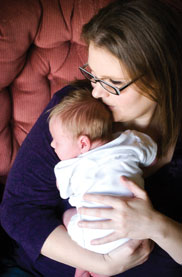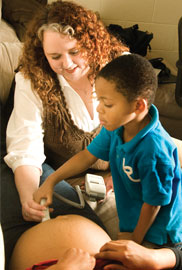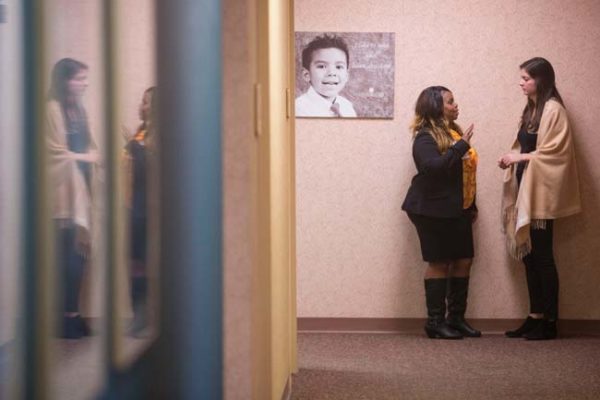The Measure of Life
After her son Christopher was born, Tracey Stamper could recite all the numbers: Jan. 12, 2010; 5:27 p.m., 7 pounds, 14 ounces; 19 ¼ inches.
But to her, the most important number was his gestational age. Her healthy baby boy defied the odds and was born at 39 weeks, nearly full-term.
Stamper is just one participant in Tennessee Connections for Better Birth Outcomes (BBO), a study investigating how all babies can go the gestational distance – especially important since Tennessee is ranked the 45th worst in the nation for pre-term births.
“Prematurity and infant mortality are huge problems,” said Melanie Lutenbacher, Ph.D., M.S.N., F.A.A.N., a principal investigator for BBO. “Mothers who have had a premature baby are more at risk to have another premature baby. We wanted to do something to help change those numbers and improve outcomes for mothers and babies.”
Home Visits
The study is for pregnant women ages 18 to 40 who have previously given birth prematurely. They are randomized into two groups. One receives care from Vanderbilt obstetric or nurse-midwifery clinics, and the other group receives the same care plus regularly scheduled prenatal home visits by a nurse-midwife during pregnancy and 18 months of postnatal home visits by a nurse.
Now in its fourth year, BBO is funded by a $2.5 million grant from Blue Cross Blue Shield of Tennessee and has already enrolled more than 200 pregnant women.

Tracey Stamper adores son Christopher. Her fears for his health have been replaced by dreams for his future.
Just as prematurity crosses all racial and socioeconomic lines, study participants come from a range of backgrounds.
On the home visits, nurses follow protocols based on research of risk factors associated with prematurity. Nutrition, stress, depression, dental health, abuse, pregnancy spacing, smoking and drug use are all considerations and factored into the interventions.
“We can’t just take our finger and point to one cause of prematurity,” Lutenbacher said. “Women may be genetically predisposed to prematurity, but without an environmental trigger, it may never surface. So, we’re looking at risk factors that we may be able to modify and improve to hopefully prevent the trigger.”
Nurse-midwives are uniquely prepared to address the myriad risk factors, says Tara Lynchard, M.S.N., C.N.M., with BBO.
“We address a woman as a whole person and not just a pregnancy or diagnosis,” she said.
Babies born prematurely can have developmental problems and are more prone to infections and respiratory issues, not to mention the toll a premature birth takes on the family.
“Everyone has that idealistic view of how their birth is going to be and what it will be like when they get to take their baby home. But a lot of times, the birth is so early that the crib isn’t set up and they haven’t bought everything they need,” Lynchard said. “Imagine the stress on that mother. Women tend to take things on themselves and wonder what they could have done differently to carry their baby to term.”
That’s why mothers are so eager to enroll in BBO when they become pregnant again.
Success Stories
Nurse-midwife Lynchard made home visits to Stamper throughout her second pregnancy. During Stamper’s first pregnancy, she was hospitalized for high blood pressure and gave birth at 34 weeks. She was determined to carry her second baby, Christopher, to term.
Stamper’s blood pressure was perfect throughout this pregnancy, but she had a new concern – type 2 diabetes. Lynchard helped keep her blood sugar under control and made sure she was getting proper nutrition.
“Our whole family changed our diet,” Stamper said. “We get fresh fruit instead of canned and don’t buy snacks to keep in the house.”
Stamper credits Lynchard for making her pregnancy much less stressful by taking time to explain everything, and her partner, Tommy West, said he noticed a difference.

Nurses for Newborns in-home visits involve everything from prenatal measurements to gauge the baby's progress to involving other family members, like Stella Johnson's son who is amazed when he hears his sibling's heart beat for the first time
“Tracey seemed to get more out of the visits and had more information about the pregnancy,” he said. “Because she had a more friendly relationship with Tara, she was calmer and more able to process and remember the information she was getting.”
This close, personal relationship with a nurse is a cornerstone of BBO.
“Our moms say our nurses are like a friend who is always there and has expert information,” Lutenbacher said. “That is such a huge part of nursing – developing those relationships and giving holistic care.”
The nurses carry a cell phone, so they are available to answer questions 24-hours-a-day, seven-days-a-week. This gives women ready access to their nurse interventionist and an additional safety net if concerns arise.
“We want them to have a good experience, especially since most of the time their preterm birth was traumatic,” Lynchard added. “We want it to be better this time.”
Stella Johnson is a 20-year-old mother hoping for a better birth experience her third time around. Her first child, Jaden, was born via Caesarean section due to fetal distress, and her second child, Christian, was born at 36 weeks when Johnson developed preeclampsia.
“I was completely unprepared,” she said about Christian’s birth. “I went in to the doctor for a normal checkup and they said my protein levels and blood pressure were off.”
She went to the hospital for lab work, but instead of going home, she was induced. Johnson wants this pregnancy to be different.
“I like having someone to call,” she said. “Last week, I was having pains and Tara immediately told me what to do. It’s helpful to immediately get in touch without having to wait.”
Home visits are relaxed and casual. Children and grandparents are invited to participate. For instance, at one of Johnson’s recent home visits, her older son was amazed at the whoosh-whoosh of the baby’s heartbeat that filled the living room, so Lynchard let him hold the fetal heart monitor wand.
Lynchard believes home visits are valuable because she gets a glimpse into what a mother’s life is really like.
“With clinic visits, most moms try to present their ‘best face,’ but they can be more relaxed and more themselves when I’m coming into their living room. It helps me see the overall situation.”
Johnson is also a full-time retail supervisor and a full-time sociology student at Fisk University. The biggest concern with her pregnancy is stress – an issue strongly associated with preterm birth and something BBO addresses with a frequently used stress management protocol.
Lynchard individualizes her guidance based on women’s interests and responsibilities.
“We work on ways mothers can cope a little better. Stella seems to be very rejuvenated by her classes, so I use that as a focus. I had another mother who had painted in her past, and we got her back into her art.”
Postnatal Care
After the babies are born, the BBO nurse-midwife, and nurses contracted separately through Nurses For Newborns, a separate non-profit nurse visitation program, make a joint visit to the mom before hospital discharge.
This “handoff” helps maintain continuity of care from the prenatal to postnatal periods.
Nurses from Nurses for Newborns continue to follow BBO study protocols for these visits, which focus on any risk factors identified in the prenatal period, increasing the time span between pregnancies, and any new factors identified since the birth.
At the home visit two weeks after his birth, Christopher Stamper had grown 1½ inches and gained 1 pound, “But it’s all in his cheeks!” his mom joked. He is in perfect health – he is a great sleeper and even has a full head of hair.
The numbers don’t lie – 39 weeks truly is a better birth outcome.
“People ask ‘What can I do to help?’” Lutenbacher said. “The answer is to educate yourself, family members, friends and co-workers about risk factors for preterm birth and that they may be modified. Encourage adoption of healthy behaviors now, and encourage all pregnant women to seek care early. Everyone needs to be involved.”







